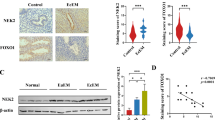Abstract
Objective
To characterize the production and degradation of hyaluronic acid (HA) in menstrual endometrial epithelial cells (EECs) and endometrial stromal cells (ESCs) in women with and without endometriosis. To identify the presence of CD44, the primary receptor of HA, in menstrual EECs and ESCs in women with and without endometriosis.
Design
In vitro study.
Setting
Academic center.
Patient(s)
Deidentified patient samples from women with and without endometriosis.
Interventions
EECs and ESCs were isolated from menstrual endometrial biopsies performed on women with (N = 9) and without (N = 11) endometriosis confirmed by laparoscopy. Main Outcome Measure: Real-time polymerase chain reaction, Western blot, and immunohistochemistry were used to assess hyaluronic acid synthase (HAS) isoforms 1, 2, and 3; hyaluronidase (HYAL) isoforms 1 and 2; and standard CD44. Student t test was used to analyze the results.
Results
There was no significant difference in messenger RNA (mRNA) or protein expression of HAS2, HAS3, HYAL1, or HYAL2 in EECs or ESCs from women with or without endometriosis. HAS1 mRNA was variably detected, whereas HAS1 protein was similarly expressed in EECs and ESCs from women with and without endometriosis. Standard CD44 was expressed in both cell types, and expression did not differ in cells from women with or without endometriosis.
Conclusions
The HA system is expressed in eutopic menstrual ESCs and EECs from women with and without endometriosis. There are no differences in expression in HA production or degradation enzymes in EECs or ESCs from women with and without endometriosis. Standard CD44 expression does not differ in eutopic menstrual endometrial cells from women with and without endometriosis.
Similar content being viewed by others
References
Wheeler JM. Epidemiology of endometriosis-associated infertility. J Reprod Med. 1989;34(1):41–46.
Simoens S, Dunselman G, Dirksen C, et al. The burden of endo-metriosis: costs and quality of life of women with endometriosis and treated in referral centres. Hum Reprod (Oxford, England). 2012;27(5):1292–1299.
Bulun SE. Endometriosis. New Engl J Med. 2009;360(3): 268–279.
Siiskonen H, Karna R, Hyttinen JM, Tammi RH, Tammi MI, Rilla K. Hyaluronan synthase 1 (HAS1) produces a cytokine-and glucose-inducible, CD44-dependent cell surface coat. Exp Cell Res. 2014;320(1):153–163.
Aruffo A, Stamenkovic I, Melnick M, Underhill CB, Seed B. CD44 is the principal cell surface receptor for hyaluronate. Cell. 1990;61(7):1303–1313.
Hasegawa A, Yoshino O, Osuga Y, et al. Hyaluronic acid reagent suppressed endometriotic lesion formation in a mouse model. Fertil Steril. 2010;93(8):2757–2759.
Knudtson JF, Tekmal RR, Santos MT, et al. Impaired development of early endometriotic lesions in CD44 knockout mice. Reprod Sci (Thousand Oaks, Calif.). 2016;23(1):87–91.
Dechaud H, Witz CA, Montoya-Rodriguez IA, Degraffenreid LA, Schenken RS. Mesothelial cell-associated hyaluronic acid promotes adhesion of endometrial cells to mesothelium. Fertil Steril. 2001;76(5):1012–1018.
Nykopp TK, Rilla K, Tammi MI, et al. Hyaluronan synthases (HAS1–3) and hyaluronidases (HYAL1–2) in the accumulation of hyaluronan in endometrioid endometrial carcinoma. BMC Cancer. 2010;10:512.
Auvinen P, Rilla K, Tumelius R, et al. Hyaluronan synthases (HAS1–3) in stromal and malignant cells correlate with breast cancer grade and predict patient survival. Breast Cancer Res Treat. 2014;143(2):277–286.
Paiva P, van Damme MP, Tellbach M, Jones RL, Jobling T, Salamonsen LA. Expression patterns of hyaluronan, hyaluronan synthases and hyaluronidases indicate a role for hyaluronan in the progression of endometrial cancer. Gynecol Oncol. 2005;98(2): 193–202.
Nykopp TK, Pasonen-Seppanen S, Tammi MI, et al. Decreased hyaluronidase 1 expression is associated with early disease recur-rence in human endometrial cancer. Gynecol Oncol. 2015;137(1): 152–159.
Rodgers AK, Nair A, Binkley PA, Tekmal R, Schenken RS. Inhi-bition of CD44 N- and O-linked glycosylation decreases endome-trial cell lines attachment to peritoneal mesothelial cells. Fertil Steril. 2011;95(2):823–825.
Griffith JS, Liu YG, Tekmal RR, Binkley PA, Holden AE, Schenken RS. Menstrual endometrial cells from women with endome-triosis demonstrate increased adherence to peritoneal cells and increased expression of CD44 splice variants. Fertil Steril. 2010;93(6):1745–1749.
Nair HB, Luthra R, Kirma N, et al. Induction of aromatase expression in cervical carcinomas: effects of endogenous estrogen on cervical cancer cell proliferation. Cancer Res. 2005;65(23): 11164–11173.
Tekmal RR, Liu YG, Nair HB, et al. Estrogen receptor alpha is required for mammary development and the induction of mammary hyperplasia and epigenetic alterations in the aromatase transgenic mice. J Steroid Biochem Mol Biol. 2005;95(1–5):9–15.
Sun M, Ramirez M, Challis JR, Gibb W. Immunohistochemical localization of the glucocorticoid receptor in human fetal membranes and decidua at term and preterm delivery. J Endocrinol. 1996;149(2):243–248.
Knudtson JF, Tekmal RR, Santos MT, et al. Impaired development of early endometriotic lesions in CD44 knockout mice. Reprod Sci (Thousand Oaks, Calif.). 2016;23(1):87–91.
Siiskonen H, Oikari S, Pasonen-Seppanen S, Rilla K. Hyaluronan synthase 1: a mysterious enzyme with unexpected functions. Front Immunol. 2015;6:43.
Rilla K, Oikari S, Jokela TA, et al. Hyaluronan synthase 1 (HAS1) requires higher cellular UDP-GlcNAc concentration than HAS2 and HAS3. J Biol Chem. 2013;288(8):5973–5983.
Csoka AB, Frost GI, Stern R. The six hyaluronidase-like genes in the human and mouse genomes. Matrix Biol. 2001;20(8): 499–508.
Ripellino JA, Klinger MM, Margolis RU, Margolis RK. The hyaluronic acid binding region as a specific probe for the localization of hyaluronic acid in tissue sections. Application to chick embryo and rat brain. J Histochem Cytochem. 1985;33(10):1060–1066.
Shibutani T, Imai K, Kanazawa A, Iwayama Y. Use of hyaluronic acid binding protein for detection of hyaluronan in ligature-induced periodontitis tissue. J Periodontal Res. 1998;33(5): 265–273.
Cyphert JM, Trempus CS, Garantziotis S. Size matters: molecular weight specificity of hyaluronan effects in cell biology. Int J Cell Biol. 2015;2015:563818.
Shinohara T, Izawa T, Mino-Oka A, et al. Hyaluronan metabolism in overloaded temporomandibular joint. J Oral Rehabil. 2016; 43(12):921–928.
Koo YH, Na YJ, Ahn MY, Jeon HN, Yeom JI, Lee KS. Expression of CD44 in endometrial stromal cells from women with and without endometriosis and its effect on the adherence to peritoneal mesothelial cells. Obstet Gynecol Sci. 2013;56(2):102–109.
Author information
Authors and Affiliations
Corresponding author
Rights and permissions
About this article
Cite this article
Knudtson, J.F., McLaughlin, J.E., Santos, M.T. et al. The Hyaluronic Acid System is Intact in Menstrual Endometrial Cells in Women With and Without Endometriosis. Reprod. Sci. 26, 109–113 (2019). https://doi.org/10.1177/1933719118766257
Published:
Issue Date:
DOI: https://doi.org/10.1177/1933719118766257




